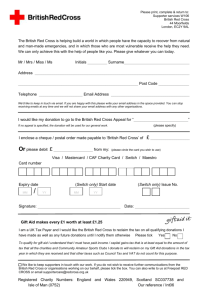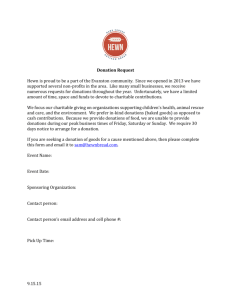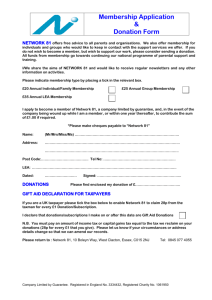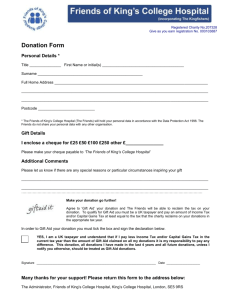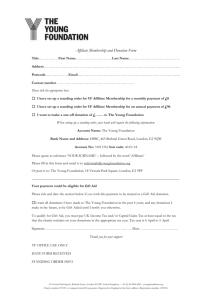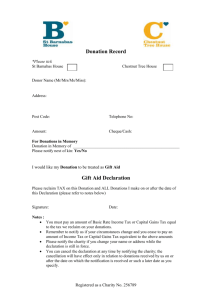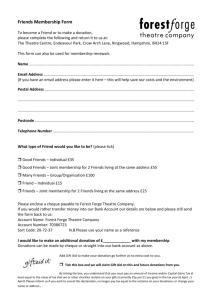Environment for Development Paying the Price of Sweetening Your Donation
advertisement
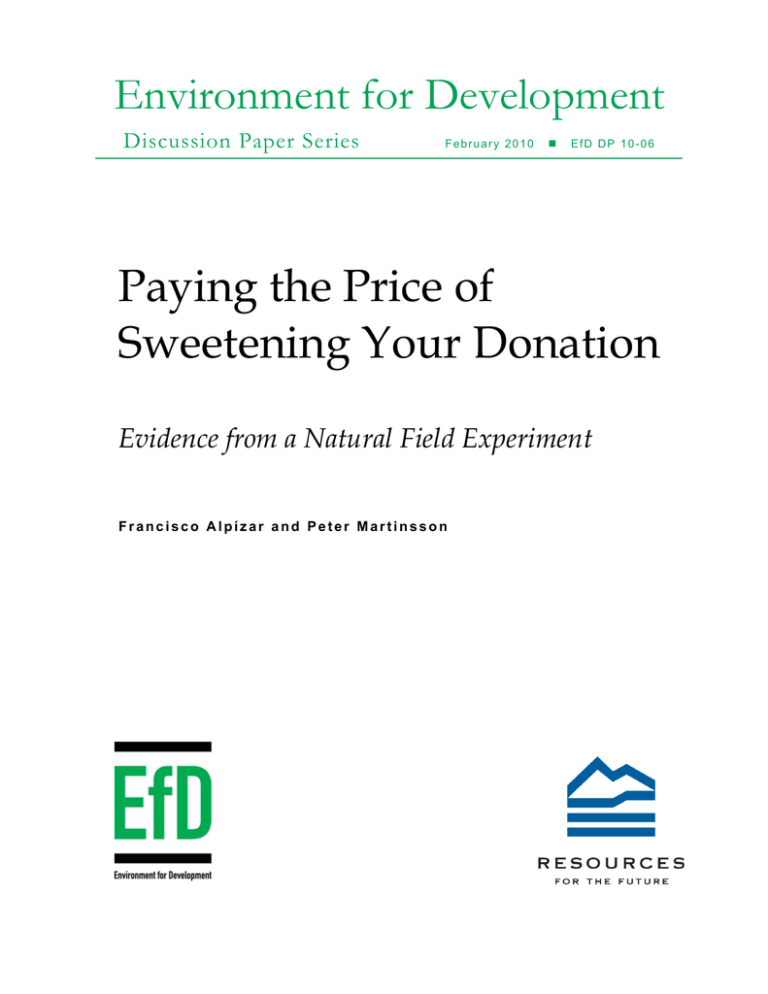
Environment for Development Discussion Paper Series February 2010 EfD DP 10-06 Paying the Price of Sweetening Your Donation Evidence from a Natural Field Experiment Francisco Alpízar and Peter Martinsson Environment for Development The Environment for Development (EfD) initiative is an environmental economics program focused on international research collaboration, policy advice, and academic training. It supports centers in Central America, China, Ethiopia, Kenya, South Africa, and Tanzania, in partnership with the Environmental Economics Unit at the University of Gothenburg in Sweden and Resources for the Future in Washington, DC. Financial support for the program is provided by the Swedish International Development Cooperation Agency (Sida). Read more about the program at www.efdinitiative.org or contact info@efdinitiative.org. Central America Environment for Development Program for Central America Centro Agronómico Tropical de Investigacíon y Ensenanza (CATIE) Email: centralamerica@efdinitiative.org China Environmental Economics Program in China (EEPC) Peking University Email: EEPC@pku.edu.cn Ethiopia Environmental Economics Policy Forum for Ethiopia (EEPFE) Ethiopian Development Research Institute (EDRI/AAU) Email: ethiopia@efdinitiative.org Kenya Environment for Development Kenya Kenya Institute for Public Policy Research and Analysis (KIPPRA) Nairobi University Email: kenya@efdinitiative.org South Africa Environmental Policy Research Unit (EPRU) University of Cape Town Email: southafrica@efdinitiative.org Tanzania Environment for Development Tanzania University of Dar es Salaam Email: tanzania@efdinitiative.org Paying the Price of Sweetening Your Donation: Evidence from a Natural Field Experiment Francisco Alpízar and Peter Martinsson Abstract Using a natural field experiment in a recreational site, a public good almost fully dependent on voluntary donations, we explored the crowding-out effect of gift rewards. First, we investigated whether receiving a map in appreciation of a donation crowded out prosocial behavior and found no significant effect of giving the map. Second, we explored the effect of adding the map to a treatment designed to increase donations. Interestingly, when the gift was combined with our attempt to trigger reputational and self image motives, the probability of donating decreased significantly, compared to the social reference treatment alone. Key Words: crowding-out, donation, natural field experiment, reciprocity JEL Classification: C93, D10, D60, Q50 © 2010 Environment for Development. All rights reserved. No portion of this paper may be reproduced without permission of the authors. Discussion papers are research materials circulated by their authors for purposes of information and discussion. They have not necessarily undergone formal peer review. Contents Introduction ............................................................................................................................. 1 1. Experimental Design ........................................................................................................... 2 2. Results .................................................................................................................................. 3 3. Discussion and Conclusions ............................................................................................... 5 References ................................................................................................................................ 7 Environment for Development Alpízar and Martinsson Paying the Price of Sweetening Your Donation: Evidence from a Natural Field Experiment Francisco Alpízar and Peter Martinsson∗ Introduction Prosocial behavior can be explained by a mix of motivational factors: intrinsic, reputational, and extrinsic (e.g., Bénabou and Tirole 2006; Ariely et al. 2009). Intrinsic and reputational motives reflect our own valuation of the “good cause” itself, as well as a desire to gain appreciation of others and oneself. Previous theoretical and empirical studies have shown that the provision of a social reference to commonly observed past behavior has a positive effect on donations (e.g., Alpízar, Carlsson, and Johansson-Stenman 2008; Frey and Meier 2004; Martin and Randall 2008). Extrinsic factors reflect positive or negative incentives that are used to affect our decisions, presumably in the direction intended by a given policy. The basic premise in economics, supported by ample evidence, is that incentives work. For example, although the social norm establishes that one should perform well at work and reputation is negatively affected if one does not, extrinsic incentives clearly help (e.g., Lazear 2000). When it comes to prosocial behavior though, the effect of incentives aimed at increasing extrinsic motivation is not so clear. In Bénabou and Tirole’s (2006, 1954) theoretical model, “the presence of extrinsic incentives spoils the reputational value of good deeds, creating doubt about the extent to which they were performed for the incentives rather than for themselves.” If no reward is offered, the agent’s action reveals only information about intrinsic and reputational motives. Recent research has shown that rewards crowd out intrinsic motivation. Titmuss (1970) argued that paying for blood donations would reduce the supply, which was confirmed in a field experiment by Mellström and Johannesson (2005). Similar results have been found, for example, in Frey and Oberholzer-Gee (1997), where acceptance of “not in my backyard” projects is ∗ Francisco Alpízar, Environment for Development Center for Central America, CATIE, 7170 Turrialba, Costa Rica, (tel) +506 2558-2215, (fax) +506 2558-2625, (email) falpizar@catie.ac.cr; and Peter Martinsson, Department of Economics, University of Gothenburg, Box 640, 405 30, Göteborg, Sweden, (tel) +46 31 786 52 55, (fax) +46 31 786 10 43, (email) peter.martinsson @economics.gu.se. Financial support from Sida (Swedish Agency for International Development and Cooperation) to the Environmental Economics Unit at the University of Gothenburg, via the Environment for Development Initiative, is gratefully acknowledged. 1 Environment for Development Alpízar and Martinsson reduced if monetary compensation is offered; and in Gneezy and Rustichini (2000), where a fine for picking children up late from day care increased the number of late pick-ups. However, Falk (2007) found that including a postcard in a letter when asking for donation to support children in need in Bangladesh had a positive effect on donations. The objective of this paper is to investigate potential crowding out of gift rewards for donations. For this purpose, we conducted a natural field experiment in a national park in Costa Rica, a public good almost fully dependent on voluntary donations. We explored crowding out in two treatments. First, we investigated whether receiving a map in appreciation of the donation crowded out prosocial behavior. Second, we investigated whether adding the map to a treatment designed to increase donations via reputational motives crowded out prosocial behavior. 1. Experimental Design The natural field experiment was conducted in Cahuita National Park (CNP) in Costa Rica. The park does not charge any entrance fee and receives approximately 50,000 visitors per year. Registration in a logbook is compulsory for everyone entering the park. Signs and posters clearly invite visitors to make a donation, and donations are duly introduced in the logbook as proof of payment.1 The experimental design in our experiment consisted of a control treatment and three main treatments: 1) receiving a gift, 2) receiving information about the most common past behavior of other visitors, and 3) combination of both receiving a gift and information about the most common past behavior of other visitors. In the control treatment, visitors were given a colorful leaflet with neutral information about the park, written in both Spanish and English. One trained local solicitor was hired to hand out the treatment leaflet, which conveyed our treatments. The gift treatment added this statement: “together with this leaflet, you will also receive a free map with general information about Cahuita National Park and details about its facilities.” This colorful map was both a nice souvenir, as well as a useful tool for fully enjoying the amenities of CNP. The social reference treatment added one of the variations of this statement: “one of the common donations per person has been US$1/$2/$3/$4,” and each visitor saw only one of these values. The highest reference amount chosen corresponded to approximately the 90th percentile 1 The logbook and the receipts are control mechanisms for the park rangers, so there is no possibility of writing false information about the amount donated. The donation can be made either in Costa Rican colones or in US dollars. (An exchange rate of CRC 500 = US$ 1 was used.) Both currencies are used interchangeably in Costa Rica. 2 Environment for Development Alpízar and Martinsson based on historical records. The combined treatment included both the map and the social reference, with the same reference values as before. We were extremely careful to avoid cross-contamination between treatments and systematic biases in the way data was collected. Each week of experiments (Tuesday–Saturday) was followed by one week of rest.2 In the treatments using a social reference point, it was important to take into account that different types of visitors (birdwatchers or beachgoers, for example) might enter at different times of the day. Consequently, the amount stated in the leaflet changed every 30 minutes cyclically, and every morning started with a different reference amount. There were no identifiable differences in the characteristics of visitors coming at different stages of our work that might cause worry about sample bias. To control for exogenous factors that could affect the decision to donate, a senior field researcher was stationed in the registration hut and managed an extended logbook. First, park rangers could either volunteer a given amount or the visitor could forthrightly request an amount to donate. Second, other visitors arriving before or after the subject might have an effect on the decision to donate. Third, because the registration book itself could provide information about the behavior of others, we used a system that hid previous entries. However, in some cases, visitors managed to see previous donations or there simply was not enough time to hide them. All three cases were carefully registered and dropped from the analyses reported in section 2. Visitors who were part of an organized tour did not decide their own contribution and were also dropped from our dataset. Finally, visitors who came to the park on more than one day might be exposed to a different treatment in each subsequent visit. Fortunately, we were able to identify multiple visitors and restricted their inclusion to their first visit. 2. Results In table 1, we present the effects of our treatments on the share of visitors making a donation, on the average conditional donation (i.e., the amount donated, given that the visitor chose to donate), and on the sample average donation.3 There are four main groups of treatments presented in table 1: 1) a control treatment where a innocuous leaflet is delivered, 2) a 2 Sundays were not included because the number of people arriving made it impossible to fully account for external effects that could jeopardize our treatments. Moreover, Mondays were the field staff’s day off. 3 All our results are based on non-parametric tests of equal shares (Fisher Chi2-test) and Wilcoxon-Mann-Whitney tests of equal underlying distributions of conditional and sample donations. 3 Environment for Development Alpízar and Martinsson reciprocity treatment, in which a map is handed out with the leaflet, 3) a social reference treatment, in which information on the four most common past donations was provided, and 4) a treatment in which the provision of a social reference was combined with the gift, which is the focus of our paper. Table 1. Descriptive Statistics on Donations Observations Share Mean conditional donation Mean total donation Control 433 0.76 1.95 1.47 Reciprocity (Map) 319 0.74 2.03 1.51 Social reference $1 78 0.91 1.67 1.52 Social reference $2 92 0.93 1.98 1.85 Social reference $3 45 0.91 2.02 1.84 Social reference $4 77 0.78 1.85 1.44 Social reference $1 and map 46 0.76 2.19 1.66 Social reference $2 and map 52 0.73 2.15 1.57 Social reference $3 and map 74 0.78 2.28 1.79 Social reference $4 and map 48 0.71 1.47 1.04 Treatment The first two treatments are not significantly different, with approximately 75 percent of the sample making donations, and a conditional donation is approximately US$ 2. Compared to the control, the provision of a reference value of $1 significantly increases the share of visitors donating (p-value = 0.003), but lowers the average conditional donation (p-value = 0.585). This was the expected result of visitors learning that others commonly give less than their own valuation of the good (average of $1.95 in the control). As reference values increased to $2 and $3, we observed a clear pattern of significantly higher shares of visitors contributing (p-values = 0.000 and 0.019), higher although not significant increases in conditional donations (p-values = 0.100 and 0.317), and significant increases in total average donations (p-values = 0.000 and 0.014). Somewhere between $3 and $4, the data indicated an inflection point, since the reference donation of $4 achieved no significant change in any of the relevant variables, compared to the control (p-values > 0.681). The combined treatment of map and social reference showed 4 Environment for Development Alpízar and Martinsson substantially smaller shares of people donating, compared to the social reference alone, while the conditional donation showed the same inflection point described above. Table 2 shows a more detailed test of crowding out. The first row shows that the map fails to trigger prosocial behavior, as all target variables are unaffected by the map. The last four rows show the results when a gift is combined with the social reference. Up to US$ 3, there is a significant reduction in the share of visitors donating, which ranges from 13 to 20 percentage points. The conditional donations are not statistically different, except for the inflection point which is more pronounced in the combined treatment. Table 2. Combined versus Separate Treatment (P-values in brackets) Treatment Differences in share of visitors making a donation Differences (US$) in average conditional donation Differences (US$) in average total donation -0.02 (0.648) +0.08 (0.642) +0.04 (0.966) -0.15 +0.52 +0.14 (0.023) (0.375) (0.460) -0.20 +0.17 -0.28 (0.001) (0.825) (0.057) -0.13 +0.26 -0.05 (0.072) (0.576) (0.459) -0.07 -0.38 -0.40 (0.372) (0.098) (0.082) Map – control (Social reference $1 and map) – (Social reference $1) (Social reference $2 and map) – (Social reference $2) (Social reference $3 and map) – (Social reference $3) (Social reference $4 and map) – (Social reference $4) 3. Discussion and Conclusions In this paper, we show how a treatment intended to trigger higher donations by appealing to reputational motives is crowded out by extrinsic incentives. Even when applied in isolation, a gift in appreciation of prosocial behavior is not a suitable motivation for increasing donations. In both these cases, if we take into account the cost of the map, we end up with a vertical or negatively sloped supply curve, as predicted in Bénabou and Tirol’s (2006) model: the free map results in a loss to the park. Our results contradict Falk (2007) who found a significant effect of gift giving. One explanation for this difference could be that motivational crowding out is larger when the intentions of gift giving are more clearly attributable to a particular “culprit” (i.e., the 5 Environment for Development Alpízar and Martinsson national park authorities), which is clearer in our paper, compared to Falk (2007), where the children in need in Bangladesh were not responsible for using the gift to raise funds. 6 Environment for Development Alpízar and Martinsson References Alpízar, F., F. Carlsson, and O. Johansson-Stenman. 2008. “Anonymity, Reciprocity, and Conformity: Evidence from Voluntary Contributions to a National Park in Costa Rica.” Journal of Public Economics 92: 1047–1060. Ariely, D., A. Bracha, and S. Meier. 2009. “Doing Good or Doing Well? Image Motivation and Monetary Incentives in Behaving Prosocially.” American Economic Review 99(1): 544– 55. Bénabou, R., and J. Tirole. 2006. “Incentives and Prosocial Behavior.” American Economic Review 96(5): 1652–78. Falk, A. 2007. “Gift Exchange in the Field.” Econometrica 75: 1501–1511. Frey, B., and S. Meier, 2004. “Social Comparison and Pro-Social Behavior: Testing “Conditional Cooperation” in a Field Experiment.” American Economic Review 94: 1717–22. Frey, B., and F. Oberholzer-Gee. 1997. “The Cost of Price Incentives: An Empirical Analysis of Motivation Crowding-Out.” American Economic Review 87(4): 746–55. Gneezy, U., and A. Rustichini. 2000. “Pay Enough or Don’t Pay at All.” Quarterly Journal of Economics 115(3): 791–810. Lazear, E.P. 2000. “Performance Pay and Productivity.” American Economic Review 90(5): 1346–61. Martin, R., and M. Randal. 2008. “How Is Donation Behavior Affected by Donations of Others?” Journal of Economic Behavior and Organization 67: 228–38. Mellström, C., and M. Johannesson. 2008. “Crowding Out in Blood Donation: Was Titmuss Right?” Journal of the European Economic Association 6: 845–63. Titmuss, R. 1970. The Gift Relationship: From Human Blood to Social Policy. London: Allen and Unwin. 7
